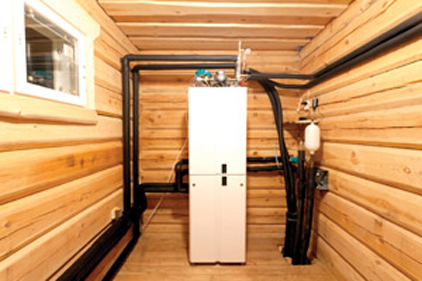While well intentioned, geothermal heat pump (GHP) incentives—including rebates, electricity cost reductions, tax incentives and grants from utilities and governments—can be detrimental to acceptance of the technology if steps aren’t taken to ensure successful installations. Even with such “carrots” to motivate adoption of GHP systems, some programs have experienced problems due to improper design, installation and validation. There are two primary reasons for this:

|
| Proffer |
• No accountability to verify the system is designed, installed and tested to validate performance and operation, or that the end-user is satisfied with the final product; and,
• A perception that someone else’s money is always necessary to pay for a GHP system, which is often entrenched in the minds of the end-users, whether they be homeowners, school boards or commercial facility customers.
Money—either directly or indirectly through various incentives—is thrown at these systems, often without any requirements other than completing minimal paperwork. The incentive provider and construction team “food-chain” assumes that the design, installation and operation will be competent and the system will work as intended. But to reduce the potential for problematic GHP installations and help ensure such programs are successful, appropriate validation and/or test confirmation procedures must be tied to these incentives.
Cause of Problem
GHP Installations
The biggest enemy of residential or commercial GHP design and installation is the dreaded “rule of thumb” mentality. Unfortunately, this assumption is often universally accepted by too many people in the mechanical engineering profession, general contractors, energy and “green” advisory consultants, mechanical contractors, architects and, yes, even those who develop GHP incentive programs.
Why? Because many engineers and tradesmen have traditionally relied on rule of thumb approaches for conventional heating and cooling systems, while nobody on the periphery comprehends the resulting impacts of higher operation and maintenance costs. The end-user is stuck paying much more to operate any system—whether mechanical or GHP—that is sized and installed using such assumptions.
Rule of thumb design and installation have absolutely no place in the GHP industry, where accurate assessment, design and installation of systems are paramount to cost and quality. While design and installation of GHP systems is really not any more difficult than competing conventional systems, GHP technologies don’t respond well to shortcuts or poor due diligence regarding design and execution.
Non-Accountability Hurts Everyone
There is no doubt that GHP systems installed without financial incentives, just like some conventional heating and cooling systems, can have mechanical and performance issues. But when incentives are tied to a problem GHP installation, the bad news goes “viral,” even if other installations in the same area are successful. As an industry, we don’t promote our successes as much as we should to counter the minority of bad jobs, and explain the difference.
This “lack of accountability” approach is repeated for GHP incentive programs in the United States, Canada and around the world. The result has been a variety of negative consequences, from adverse political fallout for those in charge of the incentives (utility and government) to failed GHP systems that can cost the customer substantial money and time to correct. Ultimately, well-intentioned incentive programs lacking accountability harm the growth and acceptance of GHP technologies.
Successful Incentive Requirements
Some GHP incentive programs, such as one administered by Manitoba Hydro, do not use taxpayer funds or investor assets without a stick behind the carrot. The result is systems that operate as intended and expected. Some incentive programs that were rife with failures and consumer complaints have been revised to include validation requirements.
After Northeast Utilities in Connecticut added “teeth” to their residential GHP incentives, the number of qualified installation contractors nosedived because many could no longer meet program requirements. This was an immediate benefit to the GHP industry because those who do qualify can provide proper load calculations, calculate loop design and provide simple functional performance tests of completed systems.
A few things are critical to constructing proper incentive requirements. Those things include: properly trained and certified looping contractors and HVAC installers of GHP systems; properly trained and certified residential and commercial designers; proper assessment of thermal conductivity values for loop design; and, finally, system performance testing to validate and prove the GHP system is working to expectations.
Some recommendations are described below that could be tied to the award/confirmation of rebates or other incentives to improve GHP installation programs:
• Residential: Completion of a basic peak load calculation (Manual J); a loop calculation using any number of available residential software programs.
• Commercial: Appropriate 8760 annual load calculation and loop design using any number of available commercial ground loop design programs.
• Residential/commercial: Technical peer review of system design by veteran GHP professional(s), at least until a contractor or engineer has a proven track record.
• Residential/commercial: Reasonable quality control of the ground loop through above-ground mechanical installation.
• Residential/commercial: Functional Performance Testing (FPT) of heat pumps to verify and validate heating/cooling capacity; efficiency as predicted by both the manufacturer’s submittal data; and as anticipated by design criteria. FPT proves performance of the ground loop, provides a service benchmark for future servicing diagnostics and identifies conflicts with controls. This process provides contractors a chance to correct systems before turning them over to the end-user.
• Residential/commercial: Peer review of FPT data by an experienced team.
Perspective on the GHP Market
The three largest manufacturers of GHPs in the world are based in the United States. Some provide OEM extended range heat pumps for other HVAC manufacturers. Many smaller U.S. manufacturers produce competing and specialty heat pumps. High-density polyethylene pipe and fittings, the key product used for closed ground loop heat exchangers, was developed and is manufactured in the U.S.
All of the best GHP internal and peripheral components are produced by U.S. vendors, including compressors, circulation pumps, valves, controls, other electrical components and blower motors. Distribution networks exist in all 50 states for all of these products, often through large, well established HVAC wholesale and commercial product representatives. Standards, specifications, design and installer training, and design criteria are all established and in place by industry associations.
The point is that the GHP industry is mature, and has gained market share not based on incentives but by competing successfully in the private sector. It is expanding and gaining acceptance as more competent installations are installed. Financial incentives are welcomed by the industry and can do much to increase the number of installations, but only if tied to some level of design, installation and performance validation.
Long-Term Objective of Incentives
Because of economies of scale, GHP technology can often compete with conventional heating and cooling systems in the commercial marketplace by demonstrating reasonable payback durations and substantially reduced life cycle costs without third-party incentives. In some cases, the GHP industry has proven examples where first cost was less than competing premium conventional systems.
The residential GHP market already has proven successful in selected markets where conditions favor the option. Paybacks against competing fuels like propane and fuel oil in many rural areas are typically within five years for the difference in installation cost of a quality conventional heating/cooling system.
Urban residential markets are tougher, as availability of low-cost natural gas or limited areas for ground loops frequently increase payback time. In this case, the total advantages of GHP systems must be considered and put in perspective against the arguments in favor of conventional HVAC options. The fact is that a standard forced air GHP provides not only heating, but cooling as well—and can make a substantial contribution to the domestic hot water load. Incentives could play a key role in breaking through this market barrier if appropriate validation measures are mandated.
At the end of the day, financial incentives for GHP installations by utilities and government should benefit the end-user and the industry by reinforcing proven design and installation standards, as well as reducing fossil fuel and power consumption and expanding consumer acceptance of GHP technologies.




Report Abusive Comment